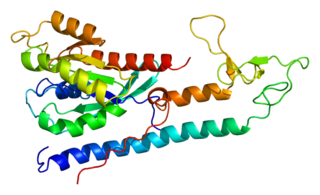Related Research Articles

Tyrosine-protein phosphatase non-receptor type 11 (PTPN11) also known as protein-tyrosine phosphatase 1D (PTP-1D), Src homology region 2 domain-containing phosphatase-2 (SHP-2), or protein-tyrosine phosphatase 2C (PTP-2C) is an enzyme that in humans is encoded by the PTPN11 gene. PTPN11 is a protein tyrosine phosphatase (PTP) Shp2.

Erbb2 interacting protein (ERBB2IP), also known as erbin, is a protein which in humans is encoded by the ERBB2IP gene. Discovered in 1997, erbin is a 200kDa protein containing a PDZ domain.

Cyclic AMP-dependent transcription factor ATF-1 is a protein that in humans is encoded by the ATF1 gene.

Ras-related protein Rab-3A is a protein that in humans is encoded by the RAB3A gene. It is involved in calcium-triggered exocytosis in neurons.

Sodium-hydrogen exchange regulatory cofactor NHE-RF2 (NHERF-2) also known as tyrosine kinase activator protein 1 (TKA-1) or SRY-interacting protein 1 (SIP-1) is a protein that in humans is encoded by the SLC9A3R2 gene.

Disintegrin and metalloproteinase domain-containing protein 12 is an enzyme that in humans is encoded by the ADAM12 gene. ADAM12 has two splice variants: ADAM12-L, the long form, has a transmembrane region and ADAM12-S, a shorter variant, is soluble and lacks the transmembrane and cytoplasmic domains.

Nuclear transcription factor Y subunit beta is a protein that in humans is encoded by the NFYB gene.

Myocyte-specific enhancer factor 2A is a protein that in humans is encoded by the MEF2A gene. MEF2A is a transcription factor in the Mef2 family. In humans it is located on chromosome 15q26. Certain mutations in MEF2A cause an autosomal dominant form of coronary artery disease and myocardial infarction.

Tyrosine-protein phosphatase non-receptor type 12 is an enzyme that in humans is encoded by the PTPN12 gene.

Calcium/calmodulin-dependent protein kinase type 1 is an enzyme that in humans is encoded by the CAMK1 gene.

Cytohesin-1 formerly known as Pleckstrin homology, Sec7 and coiled/coil domains 1 (PSCD1) is a protein that in humans is encoded by the CYTH1 gene.

Methylosome subunit pICln is a protein that in humans is encoded by the CLNS1A gene.

Beta-1-syntrophin is a protein that in humans is encoded by the SNTB1 gene.

TNF receptor-associated factor 4 (TRAF4) also known as RING finger protein 83 (RNF83) is a protein that in humans is encoded by the TRAF4 gene.

Lin-7 homolog A is a protein that in humans is encoded by the LIN7A gene.

LIM and SH3 domain protein 1 is a protein that in humans is encoded by the LASP1 gene.

MENTHO or STARD3 N-terminal like protein (STARD3NL) is an integral membrane protein of unknown function. As the alternate name implies, MENTHO, short for "MLN64 N-terminal homologue", contains a region in its N-terminus similar to that found in STARD3, also known as MLN64, but lacks the StAR-related transfer domain (START) that characterizes all other proteins given the "STARD" name. The N-terminal domain is called a MENTAL domain.

Ankyrin-3 (ANK-3), also known as ankyrin-G, is a protein from ankyrin family that in humans is encoded by the ANK3 gene.
A FFAT motif is a protein sequence motif of six defined amino acids plus neighbouring residues that binds to proteins in the VAP protein family.

StAR related lipid transfer domain containing 3(STARD3) is a protein that in humans is encoded by the STARD3 gene. STARD3 also known as metastatic lymph node 64 protein (MLN64) is a late endosomal integral membrane protein involved in cholesterol transport. STARD3 creates membrane contact sites between the endoplasmic reticulum (ER) and late endosomes where it moves cholesterol.
References
- ↑ Alpy F, Wendling C, Rio MC, Tomasetto C (2002). "MENTHO, a MLN64 Homologue Devoid of the START Domain". J. Biol. Chem. 277 (18): 50780–7. doi: 10.1074/jbc.M208290200 . PMID 12393907.
- ↑ Alpy F, Latchumanan VK, Kedinger V, Janoshazi A, Thiele C, Wendling C, Rio MC, Tomasetto C (2005). "Functional characterization of the MENTAL domain". J. Biol. Chem. 280 (18): 17945–52. doi: 10.1074/jbc.M500723200 . PMID 15718238.